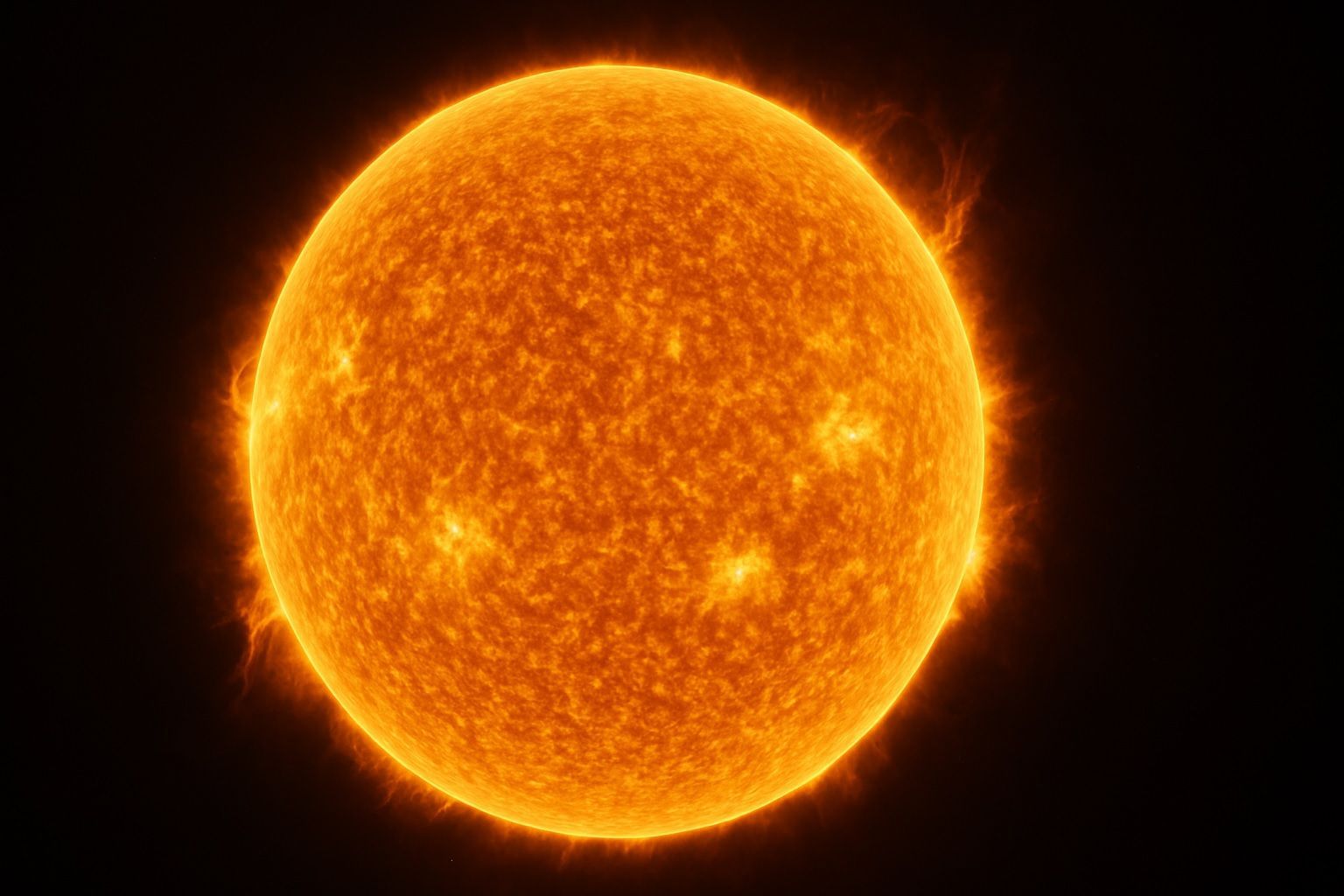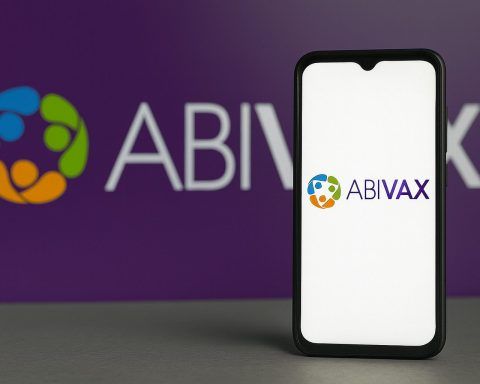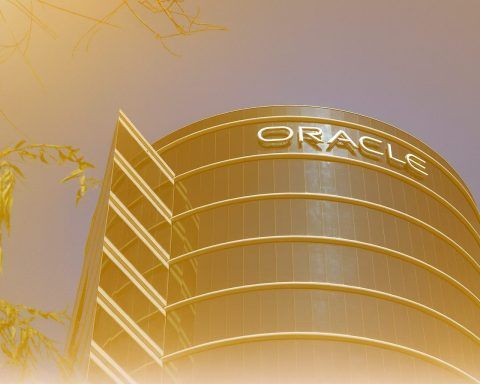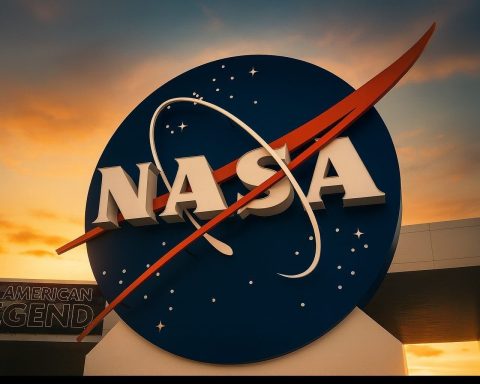- Parker Solar Probe, launched August 12, 2018 on a Delta IV Heavy, became NASA’s first mission to fly through the Sun’s corona and “touch the Sun” in April 2021 when it crossed the Alfvén critical boundary during its 8th orbit.
- At its closest approaches Parker reaches about 3.8–4 million miles (6.2 million km) from the Sun, roughly 9 solar radii, traveling faster than 430,000 mph (700,000 km/h).
- The probe’s heat shield is a 4.5-inch-thick carbon-composite foam sandwich that keeps instruments near room temperature while the shield surface heats to about 2,500°F (1,377°C).
- Parker carries four instrument suites—FIELDS, SWEAP, IS☉IS, and WISPR—to measure electric and magnetic fields, solar wind particles, and image the corona and inner heliosphere.
- WISPR observations provided the first evidence of a dust-free zone near the Sun, with dust thinning seen starting around 7 million miles from the Sun.
- Parker detected abundant magnetic switchbacks—sudden reversals in the solar wind’s magnetic field—whose origins trace back to the solar surface.
- Solar Orbiter was launched on February 10, 2020 on an Atlas V rocket, a collaboration between ESA and NASA, and is designed to image the Sun from high latitudes to view the poles for the first time.
- Solar Orbiter’s closest approach is 0.28 AU (about 42 million kilometers) from the Sun, with an aphelion near 0.9 AU, and its inclination will reach about 24° by 2026 and potentially 33° by 2029.
- Its heat shield uses multi-layer titanium foils and carbon coating to endure about 500°C, with cameras and telescopes kept behind doors until pointed at the Sun.
- Solar Orbiter carries 10 instruments—Remote Sensing: EUI, PHI, Metis, SoloHI, SPICE, STIX; In Situ: MAG, SWA, EPD, RPW—enabling both solar imaging and local plasma and magnetic-field measurements.
The Sun is our life-giving star – a 4.6-billion-year-old solar inferno that governs Earth’s climate and space environment. Understanding the Sun is not only vital for fundamental science, but also for protecting modern technology and astronauts from space weather (solar storms that can disrupt satellites and power grids) [1] [2]. Yet many solar mysteries endure, such as why the Sun’s outer atmosphere (the corona) blazes hundreds of times hotter than its surface, or how the solar wind – a stream of charged particles flowing outward – is accelerated to high speeds. In the past, scientists could only observe the Sun from afar (e.g. from Earth’s distance or via space telescopes near Earth). Now, two bold spacecraft are “touching” the Sun up close: NASA’s Parker Solar Probe and the ESA/NASA Solar Orbiter. These missions are venturing closer to our star than ever before, braving intense heat and radiation to unlock the Sun’s deepest secrets [3] [4]. This report delves into these daring missions – their objectives, designs, key discoveries, and how together they are revolutionizing solar physics.
Parker Solar Probe: NASA’s Mission to “Touch” the Sun
Launched by NASA in August 2018, the Parker Solar Probe (PSP) is humanity’s first mission to fly through the Sun’s corona – literally touching the Sun [5]. It is named after solar physicist Eugene Parker, who first predicted the solar wind in 1958 [6]. Parker Solar Probe’s primary goal is to “follow the energy” and figure out how the Sun’s corona is heated to millions of degrees and how the solar wind is accelerated [7]. In particular, scientists want to pinpoint the mechanisms that superheat the corona (defying normal expectations of heat flowing outward) and that propel solar energetic particles to near light-speed [8]. By directly sampling the Sun’s atmosphere and magnetic environment, Parker Solar Probe is providing unprecedented data to answer these questions.
Launch and Trajectory: Parker Solar Probe was launched on August 12, 2018 on a powerful Delta IV Heavy rocket [9]. The mission was designed as a seven-year journey with 24 orbits around the Sun, gradually shrinking its orbital distance using gravity assists at Venus [10]. With each Venus flyby, the spacecraft’s path is bent inward, letting it dive closer to the Sun’s surface. By its final orbits, Parker comes within about 3.8–4 million miles (~6.2 million km) of the Sun’s surface – about 9 solar radii from the Sun’s center [11] [12]. This is seven times closer than any previous spacecraft has ever come [13]. At such distances, the probe hurtles through the corona at speeds over 430,000 mph (700,000 km/h), making it the fastest human-made object in history [14] [15]. Figure 1 below compares Parker’s perihelion distance to Solar Orbiter’s and Earth’s orbit for scale.
Such a daring approach required ingenious engineering. Parker Solar Probe is equipped with a revolutionary heat shield: a 4.5-inch-thick carbon-composite foam sandwich that always faces the Sun, protecting the spacecraft and instruments from extreme heating [16] [17]. Near Parker’s closest approach, the Sun’s corona heats the shield to nearly 2,500°F (≈1,377°C, hot enough to melt steel) [18] [19]. Yet behind this shield, the probe’s instruments sit at roughly room temperature. Parker carries four main instrument suites to conduct its solar investigations [20]:
- FIELDS – a suite of sensors to measure electric and magnetic fields, plasma waves, and radio emissions in the near-Sun environment. This reveals the structure of the Sun’s magnetic field and how it interacts with plasma.
- SWEAP (Solar Wind Electrons Alphas and Protons) – instruments (like a Faraday cup) that scoop up and count the electrons, protons, and helium nuclei of the solar wind, measuring their properties (speed, density, temperature) in real time.
- IS☉IS (Integrated Science Investigation of the Sun) – two energetic particle detectors that catch high-energy particles (electrons, protons, heavy ions) accelerated by solar flares or shock waves, to understand how these particles attain such high speeds.
- WISPR (Wide-Field Imager for Solar PRobe) – a visible-light camera that peers around the edge of the heat shield to image the solar corona and inner heliosphere. WISPR can see structures like coronal mass ejections (CMEs), streamers, and even the zodiacal light from dust – effectively taking snapshots of the solar wind flowing outward [21] [22].
Key Early Discoveries: In just a few years since launch, Parker Solar Probe has rewritten our understanding of the near-Sun environment. Some of its groundbreaking findings include:
- Entering the Sun’s Corona: In April 2021 (during its 8th orbit), Parker Solar Probe became the first spacecraft to fly within the Sun’s corona, crossing the Alfvén critical boundary (where the solar wind separates from the Sun) [23] [24]. NASA announced that Parker had “touched the Sun” – a historic milestone confirmed by direct sampling of coronal particles and magnetic fields [25]. As project scientist Nour Raouafi noted, “we see evidence of being in the corona in magnetic field data, solar wind data, and visually in images… we can actually see the spacecraft flying through coronal structures” [26] [27]. By sensing the corona’s conditions up close, Parker is helping answer why the corona is so hot and dynamic.
- Magnetic “Switchbacks”: To scientists’ surprise, Parker detected wild zigzag bends in the magnetic field lines – sudden reversals pointing back toward the Sun – which were dubbed “switchbacks.” Detected as early as the first solar orbits in 2018–2019, these magnetic kinks turned out to be plentiful near the Sun [28]. Until Parker, such switchbacks were only hints in distant observations; Parker revealed they are a common feature of the young solar wind. Even more exciting, as Parker ventured closer (halving its distance by 2021), it gathered evidence that at least some switchbacks originate right at the solar surface, likely from regions of intense magnetic activity [29]. In other words, Parker traced mysterious magnetic disturbances in the solar wind back to their source on the Sun – a key clue in understanding how the solar wind is born.
- Solar Wind “Rotates” Near the Sun: Near Earth, the solar wind blows almost straight out from the Sun. But Parker’s measurements showed that close to the Sun, the solar wind plasma still co-rotates with the Sun’s rotation – like a “carousel” effect [30] [31]. Parker detected significant sideways (azimuthal) flow, with the wind curving along as the Sun turned, far stronger than predicted by models [32]. This rotation was found to break free and become radial farther out than expected [33] [34]. Implication: The point where the solar wind transitions from rotating with the Sun to blasting straight outward was farther from the Sun than theorized, meaning the Sun transfers more angular momentum to its outflow than we thought [35]. This finding helps explain how the Sun sheds energy and momentum and will improve models of stellar wind behavior for Sun-like stars.
- Dust-Free Zone Near the Sun: Decades ago, scientists predicted that within a few million miles of the Sun, interplanetary dust (microscopic grains from comets and asteroids) would be vaporized by sunlight, creating a “dust-free zone.” Parker’s WISPR imager actually saw evidence of dust thinning out about 7 million miles from the Sun, decreasing further inward toward ~4 million miles [36] [37]. This was the first direct observation confirming the long-theorized dust-free region near the Sun [38] [39]. Extrapolating the data, scientists expect an almost complete dust-free zone may exist inside ~2–3 million miles of the Sun [40], which Parker might observe as it ventures closer. This discovery not only solves a 90-year-old question about the solar system’s dust distribution, but also informs models of how sunlight and solar wind interact with particles in the inner solar system.
- Extreme Solar Storms Up Close: Parker Solar Probe’s instruments have recorded a plethora of solar phenomena from an unrivaled vantage point – from solar energetic particle bursts to traversing through shock fronts of coronal mass ejections. By “putting space weather under a microscope,” Parker has provided new insights into how solar eruptions propagate and the fine-scale structure of solar energetic particle events [41]. Each close encounter yields data that improves our ability to forecast solar storms that can impact Earth [42] [43].
Remarkably, Parker achieved all this while surviving conditions analogous to four yards from the Sun’s surface on a football field scale (with Earth at the 100-yard line) [44]. As of late 2024, Parker Solar Probe reached its planned final orbit, coming just 3.8 million miles (6.1 million km) from the Sun at perihelion on Dec 24, 2024 [45] [46]. It will continue to orbit the Sun roughly every 3–4 months at these close distances [47] [48]. Each pass yields new measurements from inside the Sun’s atmosphere. “Parker Solar Probe is braving one of the most extreme environments in space and exceeding all expectations,” said Dr. Nour Raouafi of JHU/APL. “This mission is ushering in a new golden era of space exploration, bringing us closer than ever to unlocking the Sun’s deepest and most enduring mysteries” [49] [50].
Solar Orbiter: Charting the Sun’s Poles and Beyond
Launched in February 2020, Solar Orbiter (SolO) is a collaborative mission led by the European Space Agency with NASA partnership [51]. Whereas Parker Solar Probe is like a daring solar “surfer” skimming the Sun’s atmosphere, Solar Orbiter is a solar observatory designed to study the Sun in detail from a closer-than-ever vantage point. Its unique trajectory will ultimately take it out of the ecliptic plane, allowing it to image the Sun’s polar regions for the first time [52]. Solar Orbiter’s overarching mission is to understand how the Sun creates and controls the heliosphere – essentially how solar activity generates the heliospheric magnetic field, solar wind, and energetic particles that fill our solar system [53] [54]. By combining remote sensing (telescopic observations of the Sun) with in situ measurements (of the solar wind around the spacecraft), Solar Orbiter aims to link events at the Sun’s surface to their effects in space – providing a “big picture” context for the solar wind and space weather.
Launch and Orbit: Solar Orbiter launched on February 10, 2020, from Cape Canaveral, FL, on an Atlas V rocket (provided by NASA) [55]. After liftoff, the spacecraft spent its first two years in a cruise phase, which included gravity assist flybys of Earth (Nov 2021) and Venus (multiple times) to shape its orbit [56] [57]. By design, Solar Orbiter’s path is highly elliptical: at closest approach it comes within 0.28 AU (~42 million km, or 26 million miles) of the Sun – inside the orbit of Mercury [58]. Its farthest point (aphelion) is around 0.9 AU, near Earth’s distance [59]. Each orbit lasts about 5–6 months. Importantly, Solar Orbiter’s series of Venus flybys gradually “tilt” the orbit out of the Sun’s equatorial plane. By the end of the nominal mission (2026) it will reach an inclination of ~24° to the solar equator, giving good views of the Sun’s high latitudes [60]. In an extended mission through late this decade, additional Venus flybys could boost the inclination to ~33° by 2029, offering a direct look at the Sun’s north and south poles [61] [62]. This is crucial for studying the solar dynamo and the Sun’s 11-year activity cycle, which are linked to polar magnetic fields.
Even at 0.28 AU, the Sun is roughly 13 times brighter than at Earth, so Solar Orbiter carries a sun-facing heat shield too. Its heat shield has custom titanium foils and carbon coating to endure about 500°C (932°F) temperatures, keeping the spacecraft safe. Behind peep holes in this shield sit Solar Orbiter’s cameras and telescopes, which open their protective doors only when pointed at the Sun to take images, then close to avoid overheating.
Science Instruments: Solar Orbiter is essentially a flying solar physics lab – one of the most complex solar observatories ever sent out. It carries a suite of 10 scientific instruments (funded by ESA member states and NASA) [63] [64], divided into two categories:
- Remote Sensing Instruments (Telescopes): These six instruments continually observe the Sun and corona from afar. Notable ones include:
- EUI (Extreme Ultraviolet Imager): Captures high-resolution images of the Sun’s lower atmosphere (chromosphere, transition region, and corona) in ultraviolet light [65]. EUI’s images allow scientists to search for the minute energy-release events (like tiny flares) that might heat the corona [66] [67].
- PHI (Polarimetric and Helioseismic Imager): Maps the magnetic field on the Sun’s surface (photosphere) and takes sharp visible-light images of the Sun [68]. It also measures oscillations in the photosphere for helioseismology – peering into the Sun’s interior flows [69]. PHI’s data are key to understanding the Sun’s magnetic activity and how it drives space weather.
- Metis (Coronagraph): An Italian-led coronagraph that blocks the bright solar disk to image the corona in both visible and UV wavelengths [70]. Metis observes the structure and dynamics of the corona from 1.7 to 4 solar radii from the Sun’s center [71]. It’s like having a continuous eclipse view, revealing coronal mass ejections and other phenomena in the outer corona with unprecedented detail.
- SoloHI (Heliospheric Imager): A camera that looks off to the side to photograph the solar wind and any transient disturbances (like CMEs) as they travel through space [72]. SoloHI can catch the faint glow of sunlight scattered by electrons in the solar wind, analogous to how Parker’s WISPR images the solar wind [73] [74].
- SPICE (Spectral Imaging of the Coronal Environment): An ultraviolet spectrometer that measures the corona’s plasma properties (temperature, density, composition) by observing specific UV emission lines [75]. SPICE helps link what’s seen in images with actual plasma conditions, and can, for example, help determine if small “campfire” flares are hot enough to explain coronal heating [76] [77].
- STIX (X-ray Spectrometer/Telescope): An X-ray imager that pinpoints bursts of high-energy X-rays from solar flares [78]. STIX data reveals timing, location, and energy of solar flares and microflares, complementing EUI and SPICE by highlighting the most energetic events and their role in energizing the corona and solar wind.
- In Situ Instruments: These four instruments measure the environment directly around Solar Orbiter – the particles and fields at the spacecraft’s location [79] [80]. They are analogous to Parker’s instruments (though not as close to the Sun):
- MAG (Magnetometer): High-precision magnetometers on a boom that measure the local magnetic field vector in the solar wind [81]. MAG helps track how the Sun’s magnetic field extends into space and evolves with solar activity [82].
- SWA (Solar Wind Plasma Analyser): A suite of sensors to sample protons, electrons, and heavy ions of the solar wind passing the spacecraft [83]. It measures their velocities, density, temperature, and composition [84], informing us about different solar wind streams (fast wind vs. slow wind) and their solar sources.
- EPD (Energetic Particle Detector): Detectors that count high-energy particles (like electrons and ions from solar eruptions) and analyze their energy and composition [85]. EPD sheds light on how solar particle radiation is accelerated and spreads through the heliosphere.
- RPW (Radio and Plasma Waves): Antennas and sensors that measure fluctuations in electric and magnetic fields to detect plasma waves and radio bursts [86]. Uniquely, RPW can do both in situ and remote measurements (it can eavesdrop on radio emissions from the Sun) [87]. This helps diagnose electromagnetic waves in the solar wind and the Sun’s corona.
With this payload, Solar Orbiter observes the Sun as a complex, connected system. It can image a solar flare on the surface, measure the waves and particles that flare generates, and then possibly feel the disturbance as it washes over the spacecraft days later. “Solar Orbiter is the most complex scientific laboratory ever sent to our life-giving star” notes ESA – it provides “unprecedented close-up observations of the Sun”, including the first-ever images of the Sun’s polar regions, while also measuring the solar wind and magnetic fields directly [88]. Data from Solar Orbiter’s ten instruments together give new insight into the Sun’s 11-year activity cycle and improve our ability to forecast space weather events [89].
Early Results and Discoveries: Although Solar Orbiter is only a few years into operations, it has already returned remarkable findings:
- Closest Pictures of the Sun & “Campfires”: Shortly after launch, in June 2020 Solar Orbiter made its first close solar pass (~0.5 AU) and turned on all its telescopes. The probe captured the closest images ever taken of the Sun, with about 4 times better resolution than prior solar observatories [90] [91]. In these Extreme Ultraviolet images, scientists spotted a multitude of tiny bright flares dotting the solar surface, playfully nicknamed “campfires.”Figure 2 shows an example of these campfires identified by Solar Orbiter’s EUI instrument. These miniature eruptions are like the “little nephews of solar flares – at least a million, perhaps a billion times smaller,” explained EUI principal investigator David Berghmans [92]. They seem to be happening literally everywhere in quiet regions of the Sun [93]. While their exact nature is still under study, one hypothesis is that they are frequent “nanoflares” – tiny magnetic explosions releasing heat into the corona [94] [95]. This is tantalizing, because countless nanoflares could collectively heat the corona from below. Confirming that will require measuring their temperatures and energies, which Solar Orbiter’s SPICE instrument is working on [96] [97]. The discovery of omnipresent campfires was unexpected new science from the very first images [98] [99], demonstrating the power of high-resolution observation close to the Sun.
- Unprecedented Full Sun Views: In March 2022, during its first dedicated science perihelion (~0.32 AU), Solar Orbiter was positioned almost directly between the Earth and Sun. It seized the chance to capture a mosaic of the full Sun in extreme detail, using multiple instruments together [100]. One composite image showed the Sun with a big solar corona plume at the south pole, detailed sunspots, and magnetogram data – a wealth of information. These images (released by ESA in 2022 and 2023) highlight the Sun’s changing activity as it heads toward solar maximum [101] [102]. They also showcased Solar Orbiter’s ability to provide a comprehensive view: for example, in one series, PHI provided the map of magnetic fields on the surface while EUI showed the hot plasma loops above them [103]. This holistic imaging will become even more valuable when Solar Orbiter starts getting side-views of the Sun’s poles and far side, complementing Earth-based views.
- Solar “Picoflare” Jets – Possible Solar Wind Source: One of Solar Orbiter’s most significant findings so far came from an observing campaign in March 2022 (with results published in 2023). While examining the Sun’s south polar region, Solar Orbiter’s EUI telescope spotted a multitude of tiny jets of plasma bursting outward from the corona [104]. These jets are extremely small and brief, leading scientists to call them “picoflare jets”. They appear in coronal holes (regions of “open” magnetic field at the poles from which fast solar wind flows) [105]. Previously, the solar wind from coronal holes was thought to be a relatively steady outflow. Solar Orbiter revealed instead an intermittent, peppered outflow: countless micro-jets firing like bullets, each ejecting material into space [106] [107]. The ubiquity of these tiny jets suggests they collectively could expel a substantial fraction of the solar wind from coronal holes [108] [109]. In other words, the fast solar wind might be built from millions of small spurts rather than a continuous breeze. This finding is a significant step in understanding solar wind origins, addressing the long-standing question of how solar plasma is launched on open magnetic field lines [110] [111]. “The ubiquity of the jets suggests the solar wind from coronal holes might originate as a highly intermittent outflow,” says Dr. Andrei Zhukov (Royal Observatory of Belgium) [112]. There may be even smaller, more frequent events underlying the solar wind. These observations, enabled by Solar Orbiter’s close-up view and high-resolution EUI images, provide crucial insight into processes that likely occur on other stars as well [113] [114]. Follow-up observations at higher inclination (closer to the poles) in coming years are expected to catch these jets from a better angle and quantify their contribution to the wind [115] [116].
- Linking Solar Surface to Space: Solar Orbiter has capitalized on its dual nature by tying specific solar surface features to measured space environment effects. For example, in November 2020, while still in cruise, Solar Orbiter’s instruments detected a uncharacteristic “bursty” solar wind stream. Tracing magnetic data backward, scientists linked it to an active region on the Sun that the probe’s remote-sensing instruments had observed – effectively connecting a patch of solar activity to the plasma that later swept past the spacecraft. In another instance (June 2022), Solar Orbiter observed a coronal mass ejection and then a few days later flew through the same eruption’s wake, measuring its magnetic and particle characteristics. These coordinated observations help validate models of how eruptions propagate and where they originate on the Sun.
Solar Orbiter has also recorded several solar flares and even an X-class flare (in 2022) from relatively close range, giving a treasure trove of data on high-energy radiation and particle acceleration in solar explosions [117]. Every observation window, Solar Orbiter returns fresh surprises – from seeing the ghostly zodiacal light (sunlight reflected off dust) using SoloHI [118], to catching unusual plasma waves with RPW, to mapping the Sun’s far side activity via helioseismology. The mission has already justified its premise of enabling new science by simply being closer and uniquely angled relative to the Sun.
Lastly, Solar Orbiter is a true international partnership. NASA provided the launch and also contributes instrument hardware/expertise (for instance, the SoloHI heliospheric imager is led by a U.S. team, and parts of the SWA and EPD were built with NASA support [119] [120]). The collaboration means data and discoveries are shared widely, maximizing scientific return. As ESA emphasizes, Solar Orbiter is “a space mission of international collaboration between ESA and NASA, operated by ESA” [121] – uniting the strengths of both agencies in exploring our star.
Side-by-Side: Parker Solar Probe vs. Solar Orbiter
Both missions are cutting-edge solar explorers, but they were conceived with different strategies that complement each other. Parker Solar Probe is a NASA solo mission built for extreme proximity, whereas Solar Orbiter is an ESA-led mission with heavy NASA involvement, focusing on comprehensive observations from a moderate distance [122] [123]. The table below compares some key features and milestones of the two missions:
| Aspect | Parker Solar Probe (NASA) | Solar Orbiter (ESA/NASA) |
|---|---|---|
| Mission Goal | “Touch the Sun” – sample the Sun’s corona in situ and unravel how the solar corona and solar wind are heated and accelerated [124]. Also, investigate how solar energetic particles are boosted to high speeds [125]. | “Observe the Sun up close” – obtain high-resolution imaging of the Sun (including poles) and link solar phenomena to heliospheric effects [126]. Study how the Sun creates the heliosphere, drives the solar wind, and governs space weather [127]. |
| Launch & Agency | Aug 12, 2018, on Delta IV Heavy (NASA) [128]. Managed by NASA (Goddard) and JHU Applied Physics Lab [129]. First mission of NASA’s Living With a Star program to a star (the Sun). | Feb 10, 2020, on Atlas V (ESA mission with NASA launch) [130]. Operated by ESA with instruments from ESA member states & NASA [131]. A Medium-class mission in ESA’s Cosmic Vision program [132]. |
| Trajectory | Highly elliptic, perihelion shrinking via 7 Venus flybys [133]. Equatorial orbit (inclination ~0°). Final orbits ~0.046 AU from Sun (well inside Mercury’s orbit) [134] [135]. Orbital period ~88 days at end. | Highly elliptic, perihelion ~0.28 AU (inside Mercury) [136], aphelion ~0.9 AU. Multiple Venus (and 1 Earth) flybys to incline orbit. Inclination ~17° by 2025, 24° by 2026, up to 33° if extended [137] [138]. Orbital period ~168 days [139]. |
| Closest Approach | ~3.8–4 million miles from Sun (~6.2 million km, ~9 solar radii) at perihelion [140] [141]. Reached in 2024 after successive flybys. | ~26 million miles (42 million km, ~60 solar radii) at perihelion [142]. Reached in 2022; repeats each ~6 months. Not designed to go closer due to need for imaging instruments. |
| Heat Protection | 4.5-inch (11.4 cm) carbon-composite heat shield, withstands ~2,500°F (≈1,377°C) [143]. Keeps instruments in shadow (~room temp). Solar panels water-cooled and retract near Sun. | Multi-layer titanium foil shield with special coating; front face reaches ~500°C. Sliding doors protect telescopes. Uses heat pipes to dump heat. Solar arrays pivot to limit Sun exposure. |
| Instruments | 4 instrument suites (FIELDS, SWEAP, IS☉IS, WISPR) focusing on in-situ plasma, fields, particles + a wide-field coronagraph imager [144]. No direct Sun-facing camera (to survive extreme environment). Total payload mass ~50 kg. | 10 instruments – 6 telescopes (EUI, PHI, Metis, SoloHI, SPICE, STIX) for remote sensing, and 4 in-situ instruments (MAG, SWA, EPD, RPW) [145] [146]. Extensive imaging and spectroscopy capability. Payload ~209 kg [147]. |
| Notable Firsts | First spacecraft to enter the Sun’s corona (Dec 2021 announcement) [148]. Fastest spacecraft ever (430,000 mph) [149]. Closest to Sun (record ~3.8 million miles) [150]. First in-situ detection of solar corona and near-Sun magnetic environment. | First spacecraft to image the Sun’s poles (upcoming). Took closest-ever pictures of Sun’s surface [151]. Will provide first views of Sun’s polar magnetic fields and cycle dynamics from out-of-ecliptic. Most instruments on any heliophysics mission to date. |
| Key Discoveries | – Magnetic switchbacks are abundant near Sun; Parker traced them to solar surface origins [152]. – Solar wind has strong rotational flow close to Sun, then transitions to radial flow farther out [153] [154]. – Confirmation of a dust-free zone near Sun (dust diminishing inside ~7 million miles) [155] [156]. – First direct sampling of the corona (high-energy particles, waves, etc.) revealing new plasma phenomena. | – Discovered ubiquitous mini-flares “campfires” on solar surface – potential nanoflares heating the corona [157] [158]. – Detected tiny jets (“picoflare jets”) in coronal holes that likely contribute to the solar wind outflow [159] [160]. – Multi-instrument views of solar eruptions and linking them to in-situ measurements, helping pinpoint solar wind sources [161] [162]. – First combined remote and in-situ observation of energy dissipation in corona (with Parker, 2022 – see next section). |
| Mission Status | Primary mission (24 orbits) ending 2025 [163]. As of 2025, spacecraft healthy; now in final orbit (perihelion ~3.8 million miles every ~3 months) [164] [165]. Expected to continue into an extended mission observing an increasingly active Sun during solar maximum (2024–2026). | Primary mission through end of 2026 [166]. Spacecraft performing well; already completed multiple close perihelia and flybys. Likely to be extended to 2030 [167] to maximize science (higher inclination orbits). Currently (2025) approaching peak solar activity, providing crucial data on polar magnetic fields and solar storms. |
Table: Comparison of Parker Solar Probe and Solar Orbiter missions. Key differences include Parker’s closer distance and in-situ focus versus Solar Orbiter’s imaging capabilities and high-inclination orbit. Despite different designs, they provide complementary perspectives on the Sun’s behavior.
Complementary Missions: Unraveling Solar Mysteries Together
Rather than competing, Parker Solar Probe and Solar Orbiter were envisioned to be complementary, each enhancing the other’s science. Parker Solar Probe excels at directly tasting the Sun’s atmosphere and magnetic fields up close, while Solar Orbiter provides eyes on the Sun – capturing global and high-latitude views that Parker cannot. Together, they form a two-spacecraft orchestra, coordinating measurements from different distances and angles to achieve a more complete understanding of solar phenomena.
One clear example of synergy came on June 1, 2022, when the two probes achieved a special alignment known as “quadrature.” Parker Solar Probe was making one of its close passes (at ~12 solar radii) while Solar Orbiter was positioned about 90° around the Sun from Parker’s location [168] [169]. In this configuration, Solar Orbiter’s Metis coronagraph could look side-on at the same region of the corona that Parker was flying through [170] [171]. Seizing the opportunity, the Solar Orbiter team performed an unprecedented maneuver – rolling the spacecraft 45° to keep Parker within Metis’s field of view as Parker skimmed the corona [172] [173]. For the first time, scientists obtained simultaneous measurements of the large-scale coronal structure (via Metis imaging) and the micro-scale conditions inside that region (via Parker’s in-situ instruments) [174] [175]. The reward was groundbreaking: they directly measured the rate of energy being deposited by turbulent motions in the corona – essentially catching the act of coronal heating in progress [176] [177]. This joint observation, published in 2022, provided the first empirical estimate of how turbulence converts magnetic energy into heat in the corona, a crucial piece of the coronal heating puzzle [178] [179]. It showcased how coordination of Parker and Solar Orbiter can lead to “groundbreaking achievements,” far beyond what either could do alone [180] [181].
The missions also complement each other in studying the solar wind’s journey. Parker Solar Probe might sample a stream of solar wind only a day or two after it leaves the Sun, measuring its fresh turbulence and composition. A few days later, that same stream might reach Solar Orbiter (farther out), which can then measure how the wind has evolved during transit. By comparing data, scientists can see how structures detected by Parker (say, a switchback or shock wave) change with distance and time. In March 2024, for instance, Parker and Solar Orbiter were both near perihelion (Parker at ~7.3 million km, Solar Orbiter at ~45 million km) at the same time, effectively sampling two points in the inner solar system simultaneously [182] [183]. Solar Orbiter could observe solar features, while Parker directly tasted the inner corona, allowing researchers to connect cause and effect [184]. These coordinated operations turn the two spacecraft into a mult-point observatory of the Sun and heliosphere, greatly enhancing diagnostic capability (similar to how two eyes give depth perception).
Moreover, each mission fills gaps in the other’s capabilities:
- Imaging vs. In-Situ: Parker’s direct sampling provides ground truth for physical conditions (e.g. magnetic field strength, particle distributions) that remote sensing can only infer. Conversely, Solar Orbiter’s imagers give Parker much-needed context – showing what the Sun’s surface and corona were doing at the time Parker measured a particular anomaly. For example, if Parker detects a surge in energetic particles, Solar Orbiter might have witnessed the flare or eruption that launched them. Together, they connect Sun cause → space effect in a way not possible before.
- Polar and Far-Side Coverage: Solar Orbiter’s out-of-ecliptic vantage will allow observation of the Sun’s poles (crucial for understanding the solar cycle and magnetic field reversals) [185] – something no spacecraft, including Parker, can do. Parker’s orbit stays near the Sun’s equatorial plane, so it never sees high latitudes. Solar Orbiter will eventually view these polar regions directly, and its PHI instrument will map the magnetic field at the poles for the first time, shedding light on how the Sun’s global magnetism is generated. This will complement Parker’s local measurements of magnetic fields in the solar wind emanating from polar coronal holes. Additionally, Solar Orbiter occasionally can observe the far side of the Sun (from an angle different than Earth’s line of sight), providing early warning or additional data on active regions before they rotate into Earth view. Parker has no cameras to do this, so Solar Orbiter serves as a quasi-sentry for solar activity.
- Different Distance Regimes: Parker operates within ~0.05–0.3 AU; Solar Orbiter works from ~0.3–1 AU. There’s an overlap region where both might measure the same solar wind flow at different times, but generally Parker focuses on the formation zone of the solar wind and corona, while Solar Orbiter examines the propagation and global structure. This means they can tag-team investigations across radial distance. For instance, Parker confirmed the dust-free zone near the Sun [186], and Solar Orbiter’s SoloHI can observe the dust content further out (it even imaged the zodiacal dust cloud). Parker measures switchbacks close in; Solar Orbiter’s MAG can detect if remnants of those switchbacks persist farther out. Together they cover a wider swath of the Sun’s influence.
In essence, Parker Solar Probe and Solar Orbiter were strategically timed to operate in the same solar cycle and even occasionally simultaneously at key moments, to leverage each other’s strengths. Both arrived just in time for Solar Cycle 25’s rise to maximum (expected around 2024–2025), so they are observing an increasingly active Sun in tandem. The Sun’s magnetic field is reversing and its activity (sunspots, flares, CMEs) is surging – prime conditions for the missions to capture dramatic events and to test theories in extreme cases. By comparing notes (data) from these events, scientists are obtaining a richer picture of how energy moves from the Sun’s surface, through the corona, and out in the solar wind as a connected system. This multi-mission approach is yielding transformative insights, such as:
- How coronal heating operates (turbulent energy measured by Parker in situ matches structures seen by Solar Orbiter’s coronagraph – confirming theories of turbulence-driven heating) [187] [188].
- Where different components of the solar wind originate (Solar Orbiter tracing tiny jets in coronal holes feeding the wind, complementing Parker tracing switchbacks and flows from equatorial regions) [189] [190].
- How the Sun’s magnetic field emerges and expands (Solar Orbiter mapping magnetic fields on the surface/poles, Parker measuring how those fields manifest in space as kinks, waves, and particle acceleration).
- The nature of solar transients like CMEs and shocks (Solar Orbiter’s wide-field images of a CME combined with Parker’s direct sampling inside the CME give a complete picture of its structure and impact).
Both missions have also coordinated with other space assets (e.g. Earth telescopes, NASA’s STEREO, etc.), but their partnership with each other is uniquely powerful. As a NASA commentary put it, Parker and Solar Orbiter working together offer “another vantage point” that has “revolutionized our understanding of the Sun” [191]. By joining forces, they’re painting a far more detailed, multi-dimensional view of our star.
Solar Revelations and Future Expectations
Thanks to Parker Solar Probe and Solar Orbiter, we are truly entering a new era of solar physics. Long-standing questions are being answered, and many new mysteries are emerging from the deluge of data. Some of the key scientific contributions so far include:
- Demystifying Coronal Heating: The two missions have provided concrete evidence for processes that heat the corona. Parker’s measurements within the corona showed intense turbulence and waves that likely dissipate as heat [192] [193]. Solar Orbiter’s detection of ubiquitous nanoflares (“campfires”) [194] and the first quantitative estimate of turbulent heating (from coordinated observations) [195] [196] suggest that both small magnetic explosions and turbulent cascades contribute to superheating the corona. These results are guiding refinements of solar models, bringing us closer to explaining the corona’s multimillion-degree temperature.
- Origins of the Solar Wind: We now have a much clearer picture of how the solar wind starts and evolves. Parker Solar Probe has shown that the solar wind near the Sun is not the smooth flow we see at Earth, but rather a frothy, “wired” flow full of kinks (switchbacks) and rotational motion [197] [198]. Solar Orbiter, on the other hand, has identified likely sources for both fast and slow solar wind components: fast wind being associated with myriads of tiny jets in polar coronal holes [199], and slow wind perhaps linked to active region outflows and smaller jets at the Sun’s equator. By measuring composition and particles, Solar Orbiter and Parker together also found that solar wind from different sources carries different fingerprints (for example, heavy ion abundances that match either corona holes or flare regions). This is helping to map which parts of the Sun feed the solar wind and how.
- Solar Magnetic Field & Solar Cycle: Solar Orbiter’s high-latitude view is starting to yield data on the Sun’s polar magnetic fields, which are crucial for the solar cycle. Meanwhile, Parker’s up-close field measurements have captured how magnetic fields behave in the corona (e.g. how they oscillate, reconnect, and accelerate particles). As Solar Orbiter’s inclination increases, it will take the first images of the polar regions during Solar Cycle 25’s maximum and decline. We expect to see the polar crown of magnetism and possibly catch the reversal of the Sun’s magnetic poles. These observations will feed into theories of the solar dynamo – the magnetic engine under the Sun’s surface – something that has never been directly observed before. Both missions are also studying how the Sun’s global magnetic field flips and restructures the heliosphere during the cycle.
- Space Weather Prediction: The treasure trove of data is already improving space weather forecasting. Parker Solar Probe’s close-up measurements of solar energetic particle bursts and shocks are helping model how radiation storms develop near the Sun (giving earlier indicators of when a burst might become hazardous) [200] [201]. Solar Orbiter’s imaging of CMEs from off angles provides a better estimation of their 3D shape and trajectory, making it easier to predict if and when they will impact Earth. Additionally, understanding the fine-scale structure of the solar wind (from Parker) and its sources (from Orbiter) enables more accurate models of solar wind streams that cause geomagnetic disturbances. In the long run, these missions will enhance our capability to forecast solar storms hours to days in advance, helping protect satellites, power grids, and astronauts.
Looking ahead, both missions have exciting future milestones:
- Parker Solar Probe: As of 2025, Parker is entering an extended mission around the peak of the solar cycle. This is serendipitous, because the Sun’s increased activity will provide many energetic events to study up close – flares, CMEs, and stronger solar wind conditions – testing the probe’s resilience and returning unique data. Parker will continue making a close pass every few months, and mission scientists plan to coordinate even more with Solar Orbiter and other observatories during these encounters. There is hope Parker might actually witness the proposed dust-free zone’s inner boundary if it goes below ~3 million miles in a final orbit (though no additional Venus assists are planned, the current orbit might be as close as it gets). NASA will undoubtedly push the spacecraft as far as it can safely go. How long can Parker last? The probe has limited propellant for orientation, but likely enough for several years beyond the primary mission. If it remains healthy, it could potentially operate into the late 2020s. Eventually, as funding and fuel run out, Parker will be left to orbit the Sun on its own – perhaps one day succumbing to the Sun’s gravity. But for now, it’s expected to keep “touching the Sun” and sending back new discoveries on each pass.
- Solar Orbiter: In the next few years, Solar Orbiter will progressively increase its inclination. By 2025, it will already be observing the Sun from about 17° above the equator – the highest since Ulysses (an earlier mission that had no cameras). By late 2026, after another Venus flyby, it should reach ~24° and complete its prime mission [202] [203]. If extended, further flybys in 2028 and 2029 could tilt it past 30° [204], giving truly never-before-seen views of the solar poles. These high-latitude excursions will coincide with the tail end of the current solar cycle or the start of the next, allowing Solar Orbiter to observe how the polar magnetic fields rebuild as the Sun goes toward a minimum. Additionally, Solar Orbiter’s remote sensing observations will get better as it gets closer on each perihelion (~0.27–0.29 AU for many upcoming orbits) – better resolution and sensitivity than earlier in the mission. Scientists are particularly excited to use PHI and EUI in combination to probe polar regions and possibly detect signs of plasma flows that drive the solar cycle. Solar Orbiter is also slated to work in concert with ESA’s future Vigil mission (planned for later 2020s, to monitor the Sun from a sideways angle) and with any extended Parker mission, to continue the collaborative exploration of the Sun.
In summary, Parker Solar Probe and Solar Orbiter have ushered in a new age of heliophysics. Each mission on its own is returning transformative insights: Parker, by directly plunging into the Sun’s atmosphere, and Solar Orbiter, by capturing the Sun in exquisite detail from new angles. Together, they form a one-two punch unlocking the secrets of the Sun’s corona, solar wind, and magnetic field – the very phenomena that make our star an ever-changing, dynamic force. What they’ve revealed so far is awe-inspiring: a Sun far more complex and dynamic than we saw from 1 AU, with myriad small-scale explosions and jets powering a vast heliospheric wind, and magnetic phenomena that traverse from the surface to interplanetary space.
Yet, the story is not over. As the missions continue, we can expect even more revelations. Both spacecraft will be crucial as we move into the upcoming solar maximum, likely catching some of the most energetic solar eruptions up close. They will help answer lingering questions like: How exactly do nanoflares release their energy? What role do plasma waves play in energizing particles? How do the Sun’s poles behave and influence the next cycle? And perhaps, can we predict the Sun’s outbursts more reliably? The data gathered will keep researchers busy for decades, and will refine our understanding of stellar processes in general – applying not just to our Sun but to sun-like stars across the galaxy [205] [206].
In the grandest sense, Parker Solar Probe and Solar Orbiter exemplify humankind’s drive to explore. We have sent our emissaries to the very brink of a star – “a historic moment in humanity’s first mission to a star,” as NASA’s science chief Thomas Zurbuchen remarked [207]. Every insight we gain about our Sun teaches us not only about our place in the solar system, but also about the countless other stars sprinkled across the universe [208]. With Parker and Solar Orbiter leading the way, the once unreachable Sun is finally within our grasp – our spacecraft are almost literally holding a piece of the solar inferno, and with each bit of data, helping unlock the Sun for all of us [209] [210].
Sources:
- NASA – Parker Solar Probe mission overview and press releases [211] [212] [213] [214] [215]
- ESA – Solar Orbiter mission description and instrument details [216] [217] [218]
- NASA/ESA – First images from Solar Orbiter (“campfires”) [219] [220]
- NASA – Parker Solar Probe science results (Nature 2019 papers) [221] [222]
- ESA – Solar Orbiter discoveries of tiny jets fueling solar wind [223] [224]
- NASA – Announcement of Parker Solar Probe touching the Sun [225] [226]
- ESA/NASA – Joint Solar Orbiter–Parker science (coronal heating measurement) [227] [228].
References
1. www.nasa.gov, 2. www.nasa.gov, 3. science.nasa.gov, 4. www.esa.int, 5. www.nasa.gov, 6. www.cosmos.esa.int, 7. science.nasa.gov, 8. science.nasa.gov, 9. science.nasa.gov, 10. science.nasa.gov, 11. science.nasa.gov, 12. science.nasa.gov, 13. science.nasa.gov, 14. science.nasa.gov, 15. science.nasa.gov, 16. science.nasa.gov, 17. science.nasa.gov, 18. science.nasa.gov, 19. science.nasa.gov, 20. science.nasa.gov, 21. www.nasa.gov, 22. www.nasa.gov, 23. www.nasa.gov, 24. www.nasa.gov, 25. www.nasa.gov, 26. www.nasa.gov, 27. www.nasa.gov, 28. www.nasa.gov, 29. www.nasa.gov, 30. www.nasa.gov, 31. www.nasa.gov, 32. www.nasa.gov, 33. www.nasa.gov, 34. www.nasa.gov, 35. www.nasa.gov, 36. www.nasa.gov, 37. www.nasa.gov, 38. www.nasa.gov, 39. www.nasa.gov, 40. www.nasa.gov, 41. www.nasa.gov, 42. www.nasa.gov, 43. www.nasa.gov, 44. science.nasa.gov, 45. science.nasa.gov, 46. science.nasa.gov, 47. science.nasa.gov, 48. science.nasa.gov, 49. science.nasa.gov, 50. science.nasa.gov, 51. www.esa.int, 52. www.esa.int, 53. sci.esa.int, 54. sci.esa.int, 55. en.wikipedia.org, 56. en.wikipedia.org, 57. en.wikipedia.org, 58. en.wikipedia.org, 59. en.wikipedia.org, 60. en.wikipedia.org, 61. en.wikipedia.org, 62. en.wikipedia.org, 63. www.esa.int, 64. www.esa.int, 65. www.esa.int, 66. www.nasa.gov, 67. www.nasa.gov, 68. www.esa.int, 69. www.esa.int, 70. www.esa.int, 71. www.esa.int, 72. www.esa.int, 73. www.nasa.gov, 74. www.nasa.gov, 75. www.esa.int, 76. www.nasa.gov, 77. www.nasa.gov, 78. www.esa.int, 79. www.esa.int, 80. www.esa.int, 81. www.esa.int, 82. www.esa.int, 83. www.esa.int, 84. www.esa.int, 85. www.esa.int, 86. www.esa.int, 87. www.esa.int, 88. www.esa.int, 89. www.esa.int, 90. www.nasa.gov, 91. www.nasa.gov, 92. www.nasa.gov, 93. www.nasa.gov, 94. www.nasa.gov, 95. www.nasa.gov, 96. www.nasa.gov, 97. www.nasa.gov, 98. www.nasa.gov, 99. www.nasa.gov, 100. www.pmodwrc.ch, 101. www.pmodwrc.ch, 102. www.pmodwrc.ch, 103. www.esa.int, 104. www.sidc.be, 105. www.sidc.be, 106. www.sidc.be, 107. www.sidc.be, 108. www.sidc.be, 109. www.sidc.be, 110. www.sidc.be, 111. www.sidc.be, 112. www.sidc.be, 113. www.sidc.be, 114. www.sidc.be, 115. www.sidc.be, 116. www.sidc.be, 117. www.aanda.org, 118. www.nasa.gov, 119. sci.esa.int, 120. sci.esa.int, 121. www.sidc.be, 122. www.esa.int, 123. www.sidc.be, 124. science.nasa.gov, 125. science.nasa.gov, 126. www.esa.int, 127. sci.esa.int, 128. science.nasa.gov, 129. science.nasa.gov, 130. en.wikipedia.org, 131. sci.esa.int, 132. sci.esa.int, 133. science.nasa.gov, 134. science.nasa.gov, 135. science.nasa.gov, 136. en.wikipedia.org, 137. en.wikipedia.org, 138. en.wikipedia.org, 139. en.wikipedia.org, 140. science.nasa.gov, 141. science.nasa.gov, 142. en.wikipedia.org, 143. science.nasa.gov, 144. science.nasa.gov, 145. www.esa.int, 146. www.esa.int, 147. sci.esa.int, 148. www.nasa.gov, 149. science.nasa.gov, 150. science.nasa.gov, 151. www.nasa.gov, 152. www.nasa.gov, 153. www.nasa.gov, 154. www.nasa.gov, 155. www.nasa.gov, 156. www.nasa.gov, 157. www.nasa.gov, 158. www.nasa.gov, 159. www.sidc.be, 160. www.sidc.be, 161. www.sidc.be, 162. www.sidc.be, 163. science.nasa.gov, 164. science.nasa.gov, 165. science.nasa.gov, 166. en.wikipedia.org, 167. en.wikipedia.org, 168. www.cosmos.esa.int, 169. www.cosmos.esa.int, 170. www.cosmos.esa.int, 171. www.cosmos.esa.int, 172. www.cosmos.esa.int, 173. www.cosmos.esa.int, 174. www.cosmos.esa.int, 175. www.cosmos.esa.int, 176. www.cosmos.esa.int, 177. www.cosmos.esa.int, 178. www.cosmos.esa.int, 179. www.cosmos.esa.int, 180. www.cosmos.esa.int, 181. www.cosmos.esa.int, 182. en.wikipedia.org, 183. en.wikipedia.org, 184. en.wikipedia.org, 185. www.esa.int, 186. www.nasa.gov, 187. www.cosmos.esa.int, 188. www.cosmos.esa.int, 189. www.sidc.be, 190. www.nasa.gov, 191. science.nasa.gov, 192. www.cosmos.esa.int, 193. www.cosmos.esa.int, 194. www.nasa.gov, 195. www.cosmos.esa.int, 196. www.cosmos.esa.int, 197. www.nasa.gov, 198. www.nasa.gov, 199. www.sidc.be, 200. www.nasa.gov, 201. www.nasa.gov, 202. en.wikipedia.org, 203. en.wikipedia.org, 204. en.wikipedia.org, 205. www.nasa.gov, 206. www.nasa.gov, 207. www.nasa.gov, 208. www.nasa.gov, 209. science.nasa.gov, 210. science.nasa.gov, 211. science.nasa.gov, 212. science.nasa.gov, 213. www.nasa.gov, 214. science.nasa.gov, 215. science.nasa.gov, 216. www.esa.int, 217. www.esa.int, 218. www.esa.int, 219. www.nasa.gov, 220. www.nasa.gov, 221. www.nasa.gov, 222. www.nasa.gov, 223. www.sidc.be, 224. www.sidc.be, 225. www.nasa.gov, 226. www.nasa.gov, 227. www.cosmos.esa.int, 228. www.cosmos.esa.int










